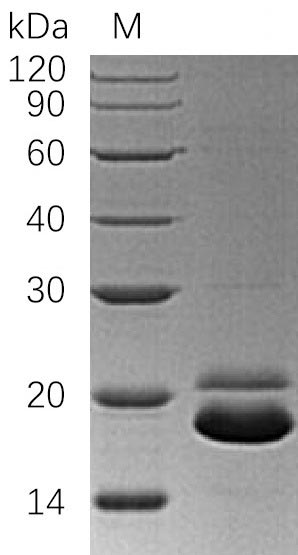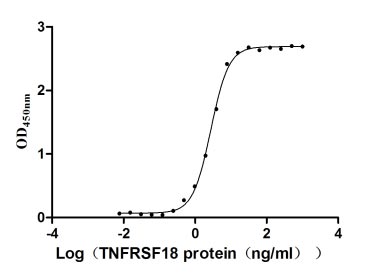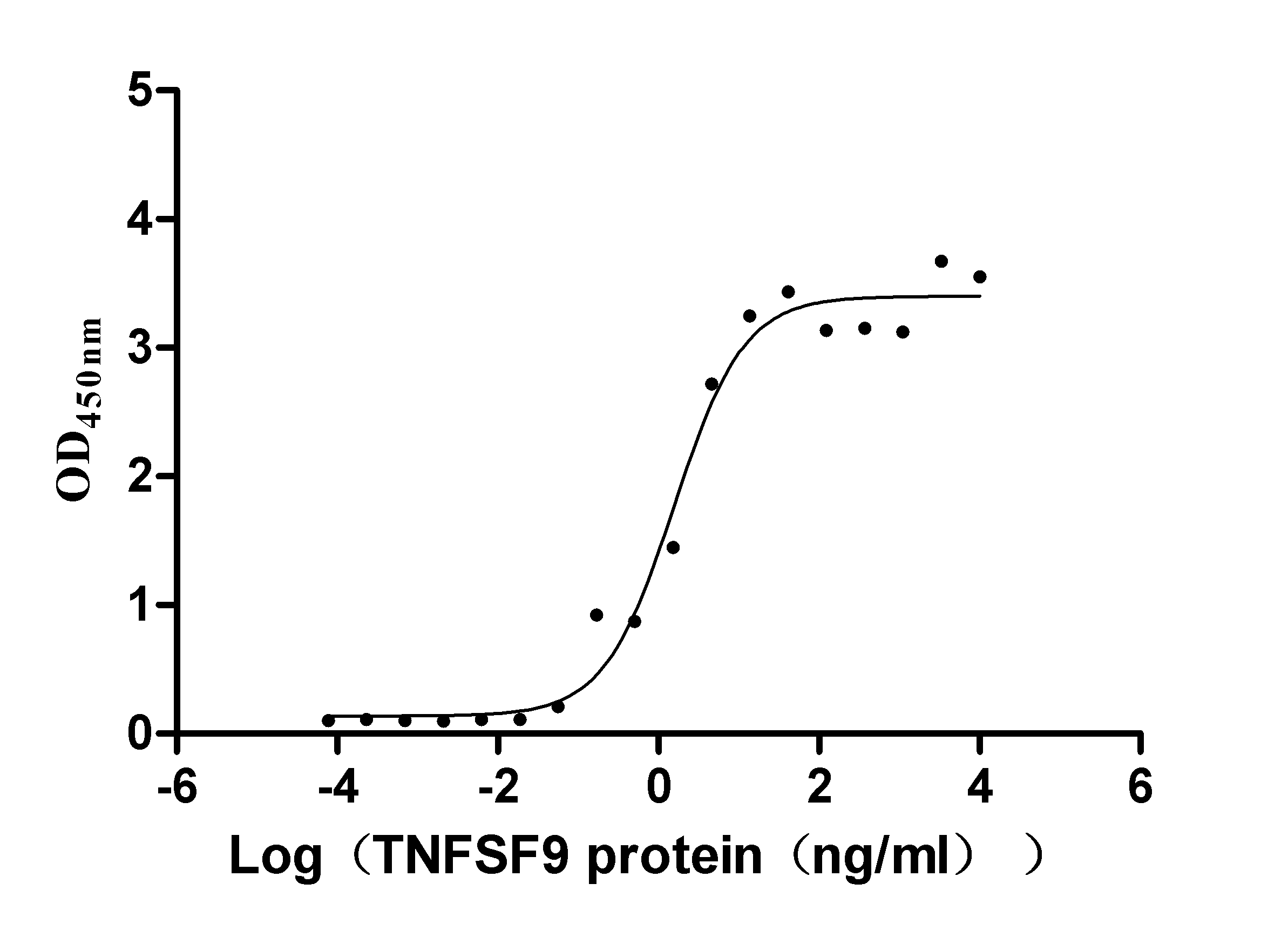Recombinant Human Tumor necrosis factor receptor superfamily member 10B (TNFRSF10B), partial (Active)
In Stock-
货号:CSB-AP004931HU
-
规格:¥468
-
图片:
-
其他:
产品详情
-
纯度:Greater than 95% as determined by SDS-PAGE.
-
内毒素:Less than 1.0 EU/μg as determined by LAL method.
-
生物活性:The ED50 as determined by its ability to inhibit TRAIL-mediated cytotoxicity using L-929 mouse fibroblast cells treated with TRAIL is 9.96 ng/ml.
-
基因名:
-
Uniprot No.:
-
别名:TNFRSF10B; DR5; KILLER; TRAILR2; TRICK2; ZTNFR9; UNQ160/PRO186; Tumor necrosis factor receptor superfamily member 10B; Death receptor 5; TNF-related apoptosis-inducing ligand receptor 2; TRAIL receptor 2; TRAIL-R2; CD antigen CD262
-
种属:Homo sapiens (Human)
-
蛋白长度:Partial
-
来源:Mammalian cell
-
分子量:15.19 kDa
-
表达区域:56-182aa
-
氨基酸序列ITQQDLAPQQRAAPQQKRSSPSEGLCPPGHHISEDGRDCISCKYGQDYSTHWNDLLFCLRCTRCDSGEVELSPCTTTRNTVCQCEEGTFREEDSPEMCRKCRTGCPRGMVKVGDCTPWSDIECVHKE
-
蛋白标签:C-terminal 6xHis-tagged
-
产品提供形式:Liquid or Lyophilized powder
Note: We will preferentially ship the format that we have in stock, however, if you have any special requirement for the format, please remark your requirement when placing the order, we will prepare according to your demand. -
缓冲液:Lyophilized from a 0.2 μm filtered 20 mM PB, 150 mM NaCl, pH 7.4
-
储存条件:Store at -20°C/-80°C upon receipt, aliquoting is necessary for mutiple use. Avoid repeated freeze-thaw cycles.
-
保质期:The shelf life is related to many factors, storage state, buffer ingredients, storage temperature and the stability of the protein itself.
Generally, the shelf life of liquid form is 6 months at -20°C/-80°C. The shelf life of lyophilized form is 12 months at -20°C/-80°C. -
货期:Basically, we can dispatch the products out in 1-3 working days after receiving your orders. Delivery time may differ from different purchasing way or location, please kindly consult your local distributors for specific delivery time.Note: All of our proteins are default shipped with normal blue ice packs, if you request to ship with dry ice, please communicate with us in advance and extra fees will be charged.
-
Datasheet & COA:Please contact us to get it.
相关产品
靶点详情
-
功能:Receptor for the cytotoxic ligand TNFSF10/TRAIL. The adapter molecule FADD recruits caspase-8 to the activated receptor. The resulting death-inducing signaling complex (DISC) performs caspase-8 proteolytic activation which initiates the subsequent cascade of caspases (aspartate-specific cysteine proteases) mediating apoptosis. Promotes the activation of NF-kappa-B. Essential for ER stress-induced apoptosis.
-
基因功能参考文献:
- in vivo data confirmed that anti-tumor activity of bigelovin in Colorectal cancer (CRC)was through induction of apoptosis by up-regulating DR5 and increasing ROS. In conclusion, these results strongly suggested that bigelovin has potential to be developed as therapeutic agent for CRC patients PMID: 28181527
- GDF-15 and TRAIL-R2 were the most powerful Proximity Extension Assay chip biomarkers in predicting long-term all-cause mortality in patients with acute myocardial infarction. PMID: 28762762
- In contrast to apoptosis, necroptotic signaling was activated similarly by both DR4- or DR5-specific ligands..Our study provides the first systematic insight into DR4-/DR5-specific signaling in colorectal and pancreatic cancer cells PMID: 29278689
- These data suggest that the humanized anti-TRAIL-R2 monoclonal antibody or the second generation of the antibody may have an important clinical usage for cancer immunotherapy PMID: 28748573
- We found that pharmacological application of Golgi stress leads to induction of death receptors (DRs) 4 and 5. DR4 appears to be primarily responsible for the initiation of cell death downstream of Golgi stress, whereas DR5 seems to be more important for cell death triggered by endoplasmic reticulum (ER) stress in specific cancer cell lines PMID: 28981087
- Knocking-down of TRAIL-DR5 gene in breast cancer cells MCF-7 markedly decreased the mRNA and protein levels of the autophagy-related factors. PMID: 29268854
- Antineoplasic agents etoposide (ET) and doxorubicin enhance the expression of Death receptor 5 (DR5) in triple-negative breast cancer (TNBC) cells. DR5 residue SerB68 is important in mediating the receptor-drug interaction. Apoptosis and DR5 expression are induced in xenograft mice and in TNBC patient-derived metastatic cells after treatment with TNF-Related Apoptosis-Inducing Ligand (TRAIL) and ET. PMID: 28702823
- DR5, BIRC5/Survivin, XIAP, c-IAP1 and c-IAP2 mRNA expression are significantly deregulated in CRC and could provide a panel of markers with significant discriminatory value between CRC and normal colorectal tissue PMID: 27827395
- The B-Raf inhibitor PLX4032 induces DR5 upregulation exclusively in Ras-mutant cancer cells; this effect is dependent on Ras/c-Raf/MEK/ERK signaling activation. PMID: 27222248
- EPHB6 induces marked fragmentation of the mitochondrial network in breast cancer cells of triple-negative origin. This response renders cancer cells more susceptible to DR5-mediated apoptosis. PMID: 27788485
- Both S1P and caspase-8 are critical for TRAF2 stabilization, polyubiquitination, subsequent activation of JNK/AP1 signaling and MMP1 expression and final promotion of cell invasion. PMID: 28482915
- DNA fragmentation, mitochondrial membrane potential and western blot analyses showed that MIC inhibited the growth of these cells by both mitochondrialmediated and death receptor (DR5)mediated apoptosis pathways PMID: 28498480
- targeting of lysosomes by chloroquine deregulates DR5 trafficking and abrogates 5-FU- but not TRAIL-stimulated cell elimination, hence suggesting a novel mechanism for receptor activation PMID: 27506940
- siRNA silencing of CHOP significantly reduced cyproterone acetate-induced DR5 up-regulation and TRAIL sensitivity in prostate cancer cells. Our study shows a novel effect of cyproterone acetate on apoptosis pathways in prostate cancer cells and raises the possibility that a combination of TRAIL with cyproterone acetate could be a promising strategy for treating castration-resistant prostate cancer PMID: 28270124
- PU.1 supports TRAIL-induced cell death by inhibiting RelA-mediated cell survival and inducing DR5 expression. PMID: 28362429
- The results demonstrated CaM binding to DR5-mediated DISC in a calcium dependent manner and may identify CaM as a key regulator of DR5-mediated DISC formation for apoptosis in breast cancer. PMID: 28092099
- The oncogene-like extracellular miR-1246 could act as a signaling messenger between irradiated and non-irradiated lung cancer cells, more importantly, it contributes to cell radioresistance by directly suppressing the DR5 gene. PMID: 27129166
- Data show that 4EGI-1 compound induced apoptosis in nasopharyngeal carcinoma cells through the death receptor 5 (DR5) on 4E-BP1 dephosphorylation exerting positive influence on their anti-tumor activities. PMID: 26942880
- Results show that downregulation of DR4 and DR5 by SLC26A2 confers resistance to TRAIL. PMID: 28108622
- Study provides direct biophysical evidence that Death Receptor 5 disulfide-linked transmembrane (TM)-dimers open in response to ligand binding. Then, to probe the importance of the closed-to-open TM domain transition in the overall energetics of receptor activation, point-mutants (alanine to phenylalanine) in the predicted, tightly packed TM domain dimer interface were designed and tested. PMID: 28746849
- Oridonin analog CYD-6-28 induces apoptosis at least partially by inducing the expression of death receptor 5 in breast neoplasms. PMID: 27387452
- The s show that cholesterol is necessary for the covalent dimerization of DR5 transmembrane domains. PMID: 27720987
- Mono treatment with lexatumumab was not sufficient to induce apoptosis in pancreatic cancer cells, whereas focal adhesion kinase inhibitor PF573228 significantly sensitized lexatumumab-induced apoptosis. Western blotting analysis revealed that lexatumumab and PF573228 combination treatment increased death receptor 5 but decreased Bcl-xL expression. PMID: 28459212
- MG132 possesses anti-gallbladder cancer potential that correlate with regulation of DR5-dependent pathway. PMID: 27277541
- CAPE/TRAIL stimulated apoptosis through the binding of TRAIL to DR5. Moreover, expression of transcription factor C/EBP homologous protein (CHOP) markedly increased in response to CAPE and transient knockdown of CHOP abolished CAPE/TRAIL-mediated apoptosis. PMID: 27260301
- Decreased level of placental TRAIl-R2 and previous C-section were found to be significantly correlated to placenta accreta. PMID: 26992667
- Results show that calmodulin (CaM) directly binds to death receptor-5 (DR5) in a calcium dependent manner in breast cancer cells. PMID: 27129269
- Bee venom inhibits colon cancer cell growth, and these anti-proliferative effects may be related to the induction of apoptosis by activation of DR4 and DR5 and inhibition of NF-kappaB activity. PMID: 26561202
- study involving a relatively large sample size showed that TNFRSF10 eQTL SNPs within lncRNAs might influence both hepatocellular carcinoma development and HBV infection PMID: 26297860
- Data show that when death receptor 5 (DR5) is suppressed, caspase-8 may recruit and stabilize TNF receptor-associated factor 2 (TRAF2) to form a metastasis and invasion signaling complex, resulting in activation of ERK signaling. PMID: 26510914
- Synthetic lipid bilayers displaying the membrane protein ligand Apo2L/TRAIL were used to stimulate death receptor-expressing cells in a modular, scalable format PMID: 26458551
- Methionine Deprivation Induces a Targetable Vulnerability in Triple-Negative Breast Cancer Cells by Enhancing TRAIL Receptor-2 Expression PMID: 25724522
- Studied an array of TRAIL-R1 and TRAIL-R2 specific variants on pancreatic cancer cells. PMID: 26138346
- The expression of two proapoptotic genes, FAS and DR5, was significantly lower in tumor samples than in adjacent normal tissues PMID: 25795228
- In an osteotropic variant of MDA-MB-231 breast cancer cells, TRAIL-R2 knockdown leads to downregulation of HMGA2, p-Src, p-Akt and CXCR4 and increased E-cadherin expression. These changes diminished occurrence of skeletal metastases in vivo. PMID: 25909161
- mutant genotype (CT+TT) of DR5 (rs1047266) may exert a negative synergistic effect on crohn disease. PMID: 26418999
- Studied the apoptosis of hepatic stellate cells induced by SEA; found it could be reduced in hepatic stellate cells that were treated with p53-specific siRNA and in hepatic stellate cells that were treated with DR5-specific shRNA. PMID: 25144704
- Taken together, our results strongly suggest that FLLL12 induces apoptosis of lung cancer cell lines by posttranscriptional regulation of DR5 through activation of protein tyrosine phosphatase(s). PMID: 25917567
- findings highlight novel mechanisms underlying endoplasmic reticulum stress-induced TNFRSF10A and TNFRSF10B expressions and apoptosis. PMID: 25770212
- DR5 expression is dramatically reduced as a function of higher prostate tumor grade. PMID: 25174820
- was statistically significant association between DR5 expression and tumor site of asal cell and squamous cell carcinoma skin cancers PMID: 24212133
- Data suggest that H-Ras inhibits TNF-related apoptosis-inducing ligand (TRAIL)-induced apoptosis through downregulation of surface death receptors DR4/DR5. PMID: 25026275
- Over-expression of TRAIL-R2 is associated with breast cancer. PMID: 25230899
- The results show that both TRAIL-R1 and TRAIL-R2 are highly expressed on human oligodendrocyte progenitors. PMID: 25845236
- Further analysis demonstrated that PARP inhibitor treatment results in activation of the FAS and TNFRSF10B (death receptor 5 (DR5)) promoters, increased Fas and DR5 mRNA, and elevated cell surface expression of these receptors in sensitized cells PMID: 24895135
- This study demonstrated lower apoptosis correlated with a deficiency of DR5 cell surface expression by CD4 T cells upon HIV-1 stimulation. PMID: 25110157
- Report RR5 up-regulation in alveolar epithelial cells from idiopathic pulmonary fibrosis patients. PMID: 24551275
- Primary EOC is associated with lower TRAIL-R2 and BCL2 expression levels, while metastatic EOC is associated with higher expression of these genes. PMID: 24190693
- Parthenolide triggers extrinsic apoptosis by up-regulating TNFRSF10B and intrinsic apoptosis through increasing the expression of PMAIP1. PMID: 24387758
- Cotreatment with MESC and an ERK inhibitor (PD98059) significantly increased the expression of DR5 to induce apoptosis...MESC may induce apoptosis via the ERK pathway and may be a potential anticancer drug candidate against human oral MEC. PMID: 24270523
显示更多
收起更多
-
相关疾病:Squamous cell carcinoma of the head and neck (HNSCC)
-
亚细胞定位:Membrane; Single-pass type I membrane protein.
-
组织特异性:Widely expressed in adult and fetal tissues; very highly expressed in tumor cell lines such as HeLaS3, K-562, HL-60, SW480, A-549 and G-361; highly expressed in heart, peripheral blood lymphocytes, liver, pancreas, spleen, thymus, prostate, ovary, uterus,
-
数据库链接:
HGNC: 11905
OMIM: 275355
KEGG: hsa:8795
STRING: 9606.ENSP00000276431
UniGene: Hs.521456
Most popular with customers
-
Recombinant Human Tumor necrosis factor receptor superfamily member 18 (TNFRSF18), partial (Active)
Express system: Mammalian cell
Species: Homo sapiens (Human)
-
Recombinant Human Tumor necrosis factor receptor superfamily member 9 (TNFRSF9), partial (Active)
Express system: Mammalian cell
Species: Homo sapiens (Human)
-
Recombinant Human Carcinoembryonic antigen-related cell adhesion molecule 6 (CEACAM6) (Active)
Express system: Mammalian cell
Species: Homo sapiens (Human)
-
Recombinant Human C-type lectin domain family 4 member C (CLEC4C), partial (Active)
Express system: Mammalian cell
Species: Homo sapiens (Human)
-
Recombinant Human Transferrin receptor protein 1 (TFRC), partial (Active)
Express system: Mammalian cell
Species: Homo sapiens (Human)
-
Recombinant Rat Gastric inhibitory polypeptide receptor (Gipr), partial (Active)
Express system: Mammalian cell
Species: Rattus norvegicus (Rat)
-
Recombinant Macaca fascicularis Dipeptidase 3(DPEP3) (Active)
Express system: Mammalian cell
Species: Macaca fascicularis (Crab-eating macaque) (Cynomolgus monkey)
-
Recombinant Human Urokinase-type plasminogen activator(PLAU) (Active)
Express system: Mammalian cell
Species: Homo sapiens (Human)





















